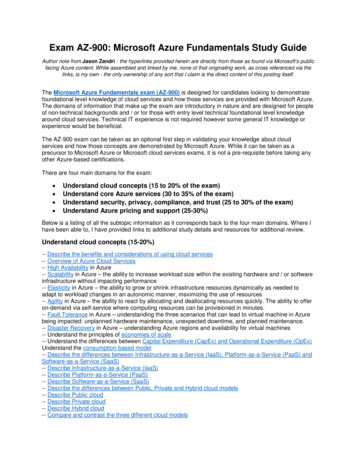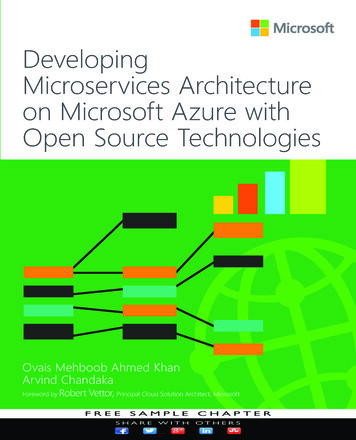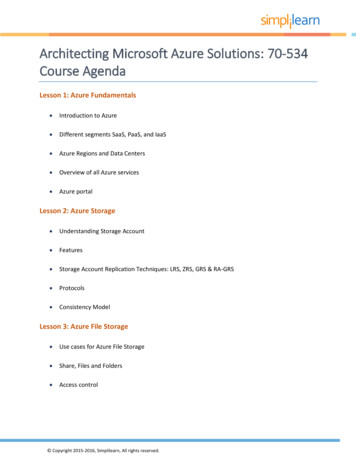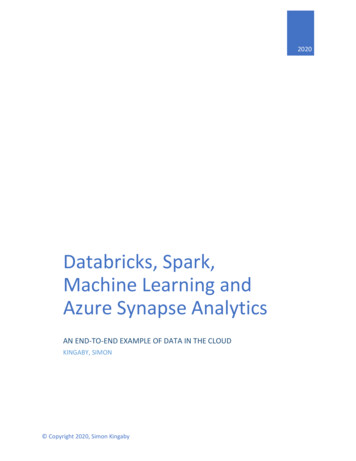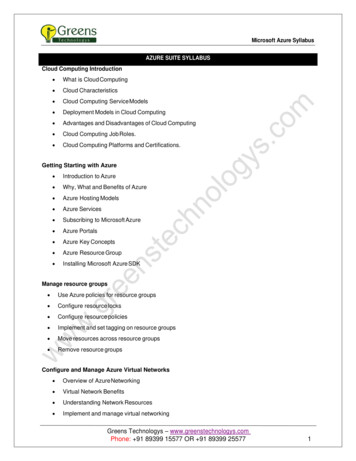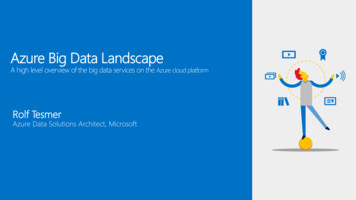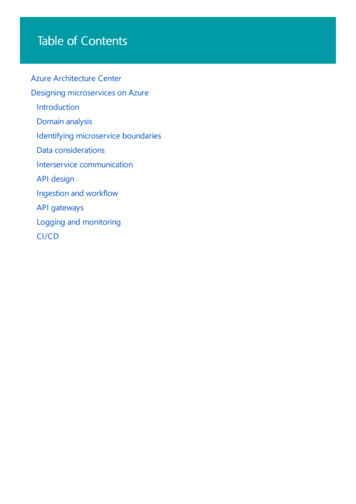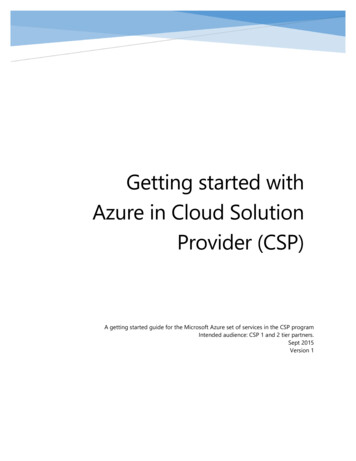
Transcription
Getting started withAzure in Cloud SolutionProvider (CSP)A getting started guide for the Microsoft Azure set of services in the CSP programIntended audience: CSP 1 and 2 tier partners.Sept 2015Version 1
Table of ContentsPre read content . 3Becoming a CSP partner . 3Getting started with Azure. 4Initial thoughts . 4Portal Access . 4What are the different roles available on the Partner Center? . 5What are the rights associated with each role on the Partner Center? . 5Cloud Solution Provider API integration - Getting Started Guide . 5Confirming the need for API integration . 5Pre-requisites. 5Developer training plan. 5Example integration project plan . 6Troubleshooting and getting help from Microsoft . 7API Learning resources . 7CREST Commerce APIs . 7Azure AD Graph APIs. 8Azure Rate card and Usage APIs . 8Azure service provisioning APIs . 8Office 365 tenant administration APIs. 8Azure in CSP API final thoughts . 8Core concepts with Azure in CSP . 8Pricing information. 8Service availability. 9Azure Data Centers and provisioning services . 9Customer tenants, subscriptions and services . 9Pay-As-You-Go (PAYG) Usage . 10Business model . 10Azure Admin Portals . 10Role Based Access control. 11Attaching to existing customer tenants . 13Customer targeting . 13Understanding fraud and other risks . 13Successful partner types . 14ISV's and Azure in CSP . 14Support model . 15
2 Tier reseller association and Partner Center experience . 162 Tier best practices . 16Enterprise Agreement vs CSP . 16Microsoft Field alignment . 16GTM guidance . 17Additional readiness resources . 18Attend Cloud Platform University Online courses . 18Additional Azure readiness materials . 18
Pre read content Read the detailed overview of CSP deck erProgram-Overview 1.pptxReview the Azure in CSP deck and video from the 2015 Worldwide Partner Conference (sessionCE20) which includes a demo of the sionResources.aspxReview the Azure in CSP FAQ – Posting to MPN in Sept, already posted on the CSP YammerPartner community or ask your Partner Sales ExecutiveVisit the New Partner Center to learn more http://Partnercenter.microsoft.com. In particular reviewthe content in the How-To sectionVisit the Azure website to find out more about what Azure is and the capabilities of the what-is-azure/Sign up for Azure university training – HereAttend the Virtual Academy on Azure Resource ManagerBecoming a CSP partnerTo become a CSP partner please register your interest at www.microsoftcsp.com and see furtherinformation at ons/cloud-reseller-overview.aspxPartners can apply to be a CSP partner in each market. You can apply to multiple markets at the aboveURL.Partners should determine their ability to perform1.2.3.4.End customer 24/7 support for the CSP services they sellScalable GTMOperational agility in the fields of provisioning, billing and service managementValue add and Solution IP that drives differentiation and profitabilityIf as a partner you cannot deliver a great customer experience in all of these 4 areas, we stronglyrecommend that you work with a 2 tier CSP partner who can provide these capabilities to you or on yourbehalf.Once you are a CSP partner, you can transact any CSP service (Office 365, EMS, CRM, Azure). Existing CSPpartners now have access to Azure.Entry requirements include signing the CSP agreement and onboarding to the platform. This is the sameprocess for all services and is only done once per market you plan to sell in.For more details on qualification and entry please see the following CSP -Provider-Program-Overview 1.pptxThe market that you are on-boarded into does not determine the Datacenter regions that you canprovision Azure services from. Each service has its list of available DC’s. Please see the Azure Managementportal for the list of supported DC’s per service.
Getting started with AzureInitial thoughtsBefore we get into detail on the portals, business model, API access etc, I want to take a few minutes toframe how to think about starting to work with Azure.Outside of general readiness, the first activity you should focus on is your solution/offering portfolio. Inthis document there are sections that describe different capabilities to enable your technicalimplementation and GTM but they all start with the design and capabilities of your offering portfolio.Getting your set of offerings right will set you up for success. Some reasons for this are: Azure is usage based with revenue only being driven once services are used; this is different tothe seat based services in CSPAccess control (delegated admin) decisions for support & admin teams and the customer userswill be driven by the offering portfolio that is being sold to the customerDecisions on channel value proposition will be determined by the offering portfolioDecisions on sales incentives and offers will be driven by the offering portfolioAlignment on customer segment and MS sales activities will be driven by your offering portfolioPortal AccessAs a partner, to transact Azure services in CSP, you need to use the new Partner Center(http://partnercenter.microsoft.com) which is the new portal for CSP partners. You use the samecredentials as the Partner Admin Center (PAC) portal. The PAC portal is the portal you may havehistorically used to manage Office 365 CSP subscriptions. We plan to consolidate all partner managementfor CSP in the Partner Center. The plan is to turn off PAC in October and the new Partner Center will bethe only partner management portal available.Today both can be used for Office 365 but only Partner Center can be used for AzureThe Partner center is only accessed by partners. Customers do not access the CSP Partner Center.Partner center is the location where you create or attach to existing customer tenants. Createsubscriptions and access the separate admin portals for specific services. You can also see billing andpricing information here.
What are the different roles available on the Partner Center?Find more information on the available roles here: http://go.microsoft.com/fwlink/p/?LinkID 617972What are the rights associated with each role on the Partner Center?Find more information on the available roles here: http://go.microsoft.com/fwlink/p/?LinkID 617972Also please see the Partner Center FAQ: ons/cloudreseller-faq.aspx#partner-centerCloud Solution Provider API integration - Getting Started GuideConfirming the need for API integrationMost partners who undertake CSP API integration work do so because they have an existing customerportal that they want to have direct integration with Microsoft commercial cloud services provisioning.This figure shows other options for provisioning services with the CSP program to compare againstcoding against the CSP APIs.Pre-requisitesTo be successful with the Cloud Solution Provider CREST APIs you should already have the following prerequisites: Must be already on-boarded as a Cloud Solution Provider partner with access tohttps://partnercenter.microsoft.comHave developers with experience using REST and JSON. All integration with the CSP APIs usesindustry standards based REST and JSON message formats over HTTPS.Ideally developers should also have experience with Azure AD authentication and C#. It is notrequired to use C# since the APIs are available to any language which supports REST, however weprovide the most comprehensive sample code in C# using Visual Studio 2015 and .NETFramework 4.5Developer training planMake sure you know who your software developers are who will be working on the integration project. Itcould be you. They should review the available training material for working with the CSP APIs. We have
links to this at the end of this document and it includes videos, MSDN documentation, MSDN forumsFAQs, Code samples, and additional guidance.Once the introductory material is completed. Developers can get up to speed by working through theseexercises:1.2.3.4.5.Request an integration sandbox account from Partner CenterRequest an App ID and client secret from Partner CenterBuild and run the CSP sample code from GitHubBuild and run an Azure AD sample from GitHubRun a network trace and monitor the HTTP request and responseExample integration project planMost partners who are integrating with the CSP APIs have an existing customer portal system that theysell to customers with. This customer portal may be linked to other internal systems such as an orderingsystem and a billing system. These existing systems need to work with an interface module that connectsto the CSP APIs as shown in the following diagram.A project plan for the integration work should include the following steps:1.2.3.4.5.6.7.Training time for developers on new tools and technologiesDocument system architecture of existing customer portal and associated systemsPlan for CSP API integration pointsReview system architecture changes and improveBuild out code proof of concept using CSP Integration SandboxReview proof of concept code and improveBuild solutionTo determine how much work will be required for this integration we recommend you have the team thatwould be doing the coding development time estimate the above integration work. Development teamsshould consider the integration interface module, any changes to your ordering and billing systems, anytraining or new technologies that they aren’t familiar with and also time for integration testing.
Troubleshooting and getting help from MicrosoftWhen troubleshooting a CSP API integration issue use some of the following guidance to identify andresolve the issue you are seeing.1.2.3.4.5.6.7.8.Become familiar with and handle all the error conditions from the CSP APIs. These are welldocumented in the MSDN documentation and most CREST API errors also return a JSON errorstructure with details of the error.Get the HTTP layer REST message request and response from the code that you are running andvalidate that against the sample messages in the MSDN documentation. You will also need theserequests and responses logged in case you submit a post to the MSDN forum or to Microsoftsupport.Use the provided C# sample code and replicate the scenario with that. Do this even if you don’tregularly use C#. Replicating the scenario in this simple code base will allow you to see what RESTcode is sent to Microsoft when the scenario is working. Of if it doesn’t work with the sample code,you will have more information about the problem you are encountering.Post your request on the MSDN forums and include your scenario, your code snippet, and theHTTP log of your request and response. Make sure to remove your client secret from the sign-inrequest if you are including that to avoid security issues.You can use break fix support from the Partner Center web portal. This is available if you havesomething that you built and it was working, you changed nothing, and it appears that theMicrosoft end of the integration stopped working. When you access break fix support it directsyou to the Office 365 admin portal and be sure to select Partner Center APIs as the category ofthe support request.You can use MPN partner benefit support incidents for API on-boarding assistance to ask for helpwith doing API integration.You can also use Microsoft Premier Support hours or Microsoft Advanced Support for Partnersincidents to similarly ask for API on-boarding assistance.The latest updated FAQ for the API’s can be found here: http://aka.ms/cspapifaqAPI Learning resourcesCREST Commerce APIsPurpose: For creating and editing new customers and for provisioning new subscriptions to thosecustomers. Intro onboarding video: https://youtu.be/8RRssasC2YsMSDN Documentation: ter/dn974944.aspxMSDN Forums: e?forum partnercenterapiCode samples: PI-DotNet/MSDN Forums FAQ: spx?id 48218
Azure AD Graph APIsPurpose: Partners can get a list of their customers, a list of each customer’s users, can add and edit userdetails, can assign Office 365 seat licenses to specific users, and can add users to the admin group suchthat they can use the Azure management portal. MSDN Documentation: 74476.aspxMSDN Forums: S/home?forum WindowsAzureADCode samples: API-DotNetAzure Rate card and Usage APIsPurpose: Partners can review near real time Azure service usage data from the Usage APIs and can lookupservice costs per datacenter and date range with the rate card APIs. Overview: ticles/billing-usage-rate-cardoverview/MSDN Documentation: 18998.aspxSample code: https://github.com/Azure/BillingCodeSamplesAzure service provisioning APIsPurpose: Once the Azure subscription is setup you may want to provision specific services and administerthem. MSDN Documentation: 78292.aspxOffice 365 tenant administration APIsPurpose: To administer an Office 365 tenant that has been set up. For example to set a mailbox quota. Documentation: http://dev.office.comAzure in CSP API final thoughtsThe Main API’s for CSP are CREST and GRAPH. These let you provision customers and subscriptions andassign users. These are the same API’s for all services in CSP. If you have coded for CREST for Office –youare well on the way to provisioning Azure services.Whilst Usage and Ratecard API’s are in fact available outside of CSP for all customers, you want to accessthese through CREST so they take advantage of your context as a CSP partner. See the section on Usagein the above Partner Center API documentation.Core concepts with Azure in CSPPricing informationPricing information is found on the partner center in the Sales section. Partners need to be logged intoPartner center to access this page. Pricing information can also be queried by the Ratecard API.
Non CSP partners can talk to their Partner Sales Executive to discuss pricing information under NDAThe section looks like this:Service availabilityOver the next 6 months we will be rolling out all the Azure services into CSP. At launch to keep track ofwhat’s available please see the Release Notes documentation and Price list which has further info onwhat’s available. We recommend partners continue to check back on this information often. Thesedocuments are found in the Sales section of the Partner Center. CSP Partners need to be logged into thePartner Center to access this section. Non CSP partners can talk to their Partner Sales Executive to discussservice availability under NDAThe section on Partner Center looks like this:Azure Data Centers and provisioning servicesYou can provision an Azure service into any available data center for that service, irrelevant of thecustomer or partner location. Please see the data center location availability for services in the AzureManagement portal.Customer tenants, subscriptions and servicesWith Azure we have the following hierarchy:Each customer has its own customer tenant. This is a tenant in Azure Active directory. It’s created whenthe first service is sold to a customer. It can be created by any service and can be created when acustomer is sold a service by any licensing program.Under a customer tenant are subscriptions. A customer tenant can have multiple Azure subscriptions. Infact, in Partner Center you can name subscriptions with custom names, which is a useful to associatesubscriptions with a particular project or just to keep track of them per customer. With the Multi-Channeland Multi-CSP Partner capabilities a customer tenant can have subscriptions from different partners anddifferent license types. Security is enforced at the boundary of the subscription in this case.An Azure subscription can have different Azure services configured. By default, there are no servicesrunning inside an Azure subscription. Therefore when no services are running, no costs are occurring andthere is no billing requirement for subscriptions with no services.
Pay-As-You-Go (PAYG) UsageAzure in CSP is a PAYG service. In that, Microsoft only bills the partner for usage inside customersubscriptions for what’s been used by the running services. It is not a per seat based license like Office.This means that partners that create and deploy Azure services will drive revenues. Just transacting anAzure subscription will not generate revenue from the cloud services as no services are running by default.Each service has a meter or meters that detail what the appropriate rating and pricing is for each service.Details are found in the pricing file on Partner Center.Because the model is usage based, billing is in arrearsBusiness modelThe Business model for Azure is the same as the other services in CSP. The wholesale discount is ingeneral 15% off the retail price of Azure for Microsoft’s 1st party services. For specific pricing informationplease see the pricing file on Partner Center. Additional incentives may be available. Please speak withyour account manager for details.Partners are billed in arrears monthly for usage.Azure Admin PortalsPartners use the Partner Center to create and manage customer tenants and subscriptions. To manageand create Azure services, partners use the Azure Management portal. When you select the AzureManagement portal link in Partner Center for an Azure subscription, the partner admin is logged into theAzure management portal in the context of a customer and can then manage the services for thatcustomer’s subscription.In the following example on the Partner Center we have a customer “GarthFishing” that has an Office 365and Azure subscription and you can see as a result a link to their appropriate management portals.By clicking on the Microsoft Azure Management Portal link the partner user is logged into the AzureManagement portal in the context of the customer GarthFishing:
If you have an account that has rights to a customer’s subscription you can also log directly into the AzureManagement portal at http://portal.azure.com.Role Based Access controlRole based access control is a core component of Azure in CSP. It is how we enable the sales motions ofResale and Managed Services for Azure in CSP.By default, when a partner creates an Azure subscription for a customer. Only the partner has permissionsto the subscription. This supports the managed services motion. In this case every time the customerwants to configure or make a change to their Azure services they have to ask the partner to make thosechanges on their behalf.The partner can also grant the customer permissions at either the subscription or Azure resource managerlevel. This is done in the Azure Management portal and not in Partner Center. We recommend grantingcustomers “Contributor” rights so they cannot remove the partner from the subscription.If a customer has permissions to the subscription, the customer can create and manage any availableMicrosoft Azure service. The partner would need to track what services are being configured as you as aCSP partner are on point for support of the services the customer creates: potentially unbeknownst to youand to collect payment for those services.We recommend partners think very carefully about their operational, contractual, support and businessmodels before granting customers access to the subscriptions.Please see more information on the permissions model used in Azure icles/role-based-access-control-configure/It’s also worth attending the Virtual Academy session on Azure Resource Manager (ARM) as a greatbackgrounder on how Azure works in this area.
Once a customer has been granted permissions to a subscription they log in directly to the Azure portal(http://portal.Azure.com) with their customer credentials to configure the services. The customer does notlog into the Partner Center.IMPORTANT:If partners choose to grant customers permissions to Azure subscriptions, we strongly recommend thatyou have a methodology to query the usage of services inside the subscription more frequently than themonthly billing cycle to keep an eye on growing usage and potential fraudulent behavior. To do this,please use the Usage API nter/mt219214.aspxGoing forward, we plan to enable more tools natively in Partner Center that help you throttle, cap andnotify based on usage.Below are some screenshots of the above described actions in the management portals:Here is the detail of a CSP subscription inside the customer tenantIn the Access section we can see roles:If I select the contributor’s role, I can add a user from the customer’s Azure Active Directory to thesubscription.
This grants that user contributor rights to the subscription and they have can now manage services insidethe subscription.I can also choose to add permissions at the Azure resource manager level by clicking the 3 dots belowreseller:This gives the partner, the ability to give more granular access to the customer. So for instance I couldgrant the customers user, “contributor” rights just to the Virtual Machine Resource Manager. Again tolearn more review the working with permissions document for ARM hereAttaching to existing customer tenantsPlease see detail in the Partner Center Overview deck Partner Center OverviewCustomer targetingPartners can use CSP to sell Azure to any customer segment. The partner’s solution portfolio willdetermine the value proposition and suitability for the intended target customer segmentUnderstanding fraud and other risksAs a partner you are taking on responsibility to manage your customers and to bill and perform accountreceivables. Therefore, you should be aware of your risks when it comes to fraud and non-payment. Formore guidance in this are please see the following content on the Partner Center
t157018.aspxSuccessful partner typesWe believe the partners who will be successful will be those that drive consumption through customercentric solutions and if possible wrap those in managed services.Typical existing partner types that might make great CSP partners are SI’s, Hosting Partners and Managedservices providers but this is not exclusive. A successful partner will be one who can deliver a greatcustomer experience, through a solution portfolio that solves a particular customer need. In most caseswe don’t expect the standalone resell of Azure services to be a highly effective GTM model.ISV's and Azure in CSPPartners who build and package intellectual property for delivery to customers are critical to the successwith Azure. Simply because without this IP in many cases raw platform services don’t solve customerneeds.Many partners have multiple personas and even if they classify themselves as a hoster, or an SI forexample they may also have ISV capabilities.Therefore I wanted to take a few moments to talk through how we think about ISV’s and Azure.If the ISV is both an managed service provider or reseller and an ISV and they will be reselling Azuresubscriptions to customers and the end customer is known to Microsoft than they can use CSP to resellthe Azure su
Today both can be used for Office 365 but only Partner Center can be used for Azure The Partner center is only accessed by partners. Customers do not access the CSP Partner Center. Partner center is the location where you create or attach to existing customer tenants. Create subscriptions and access the separate admin portals for specific services.

